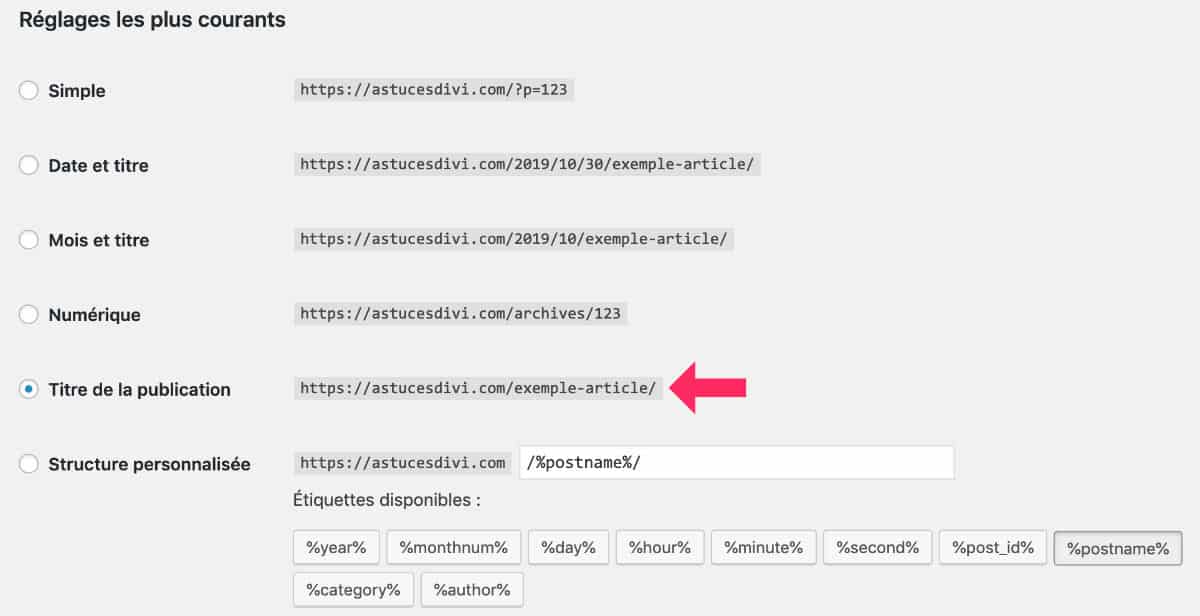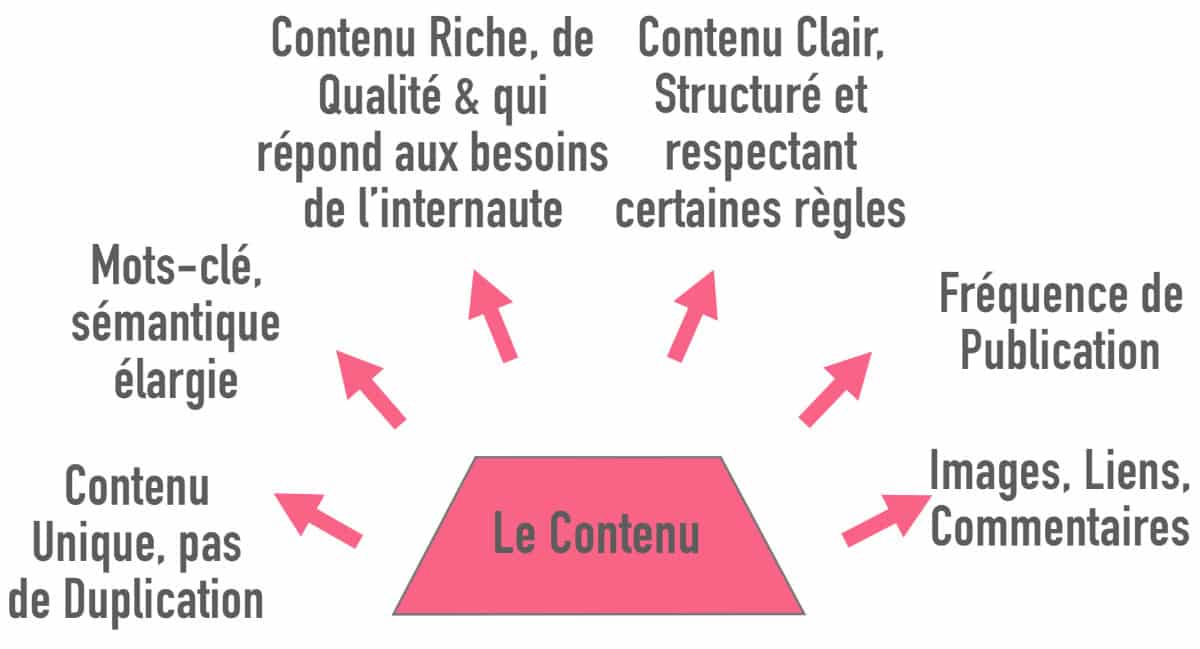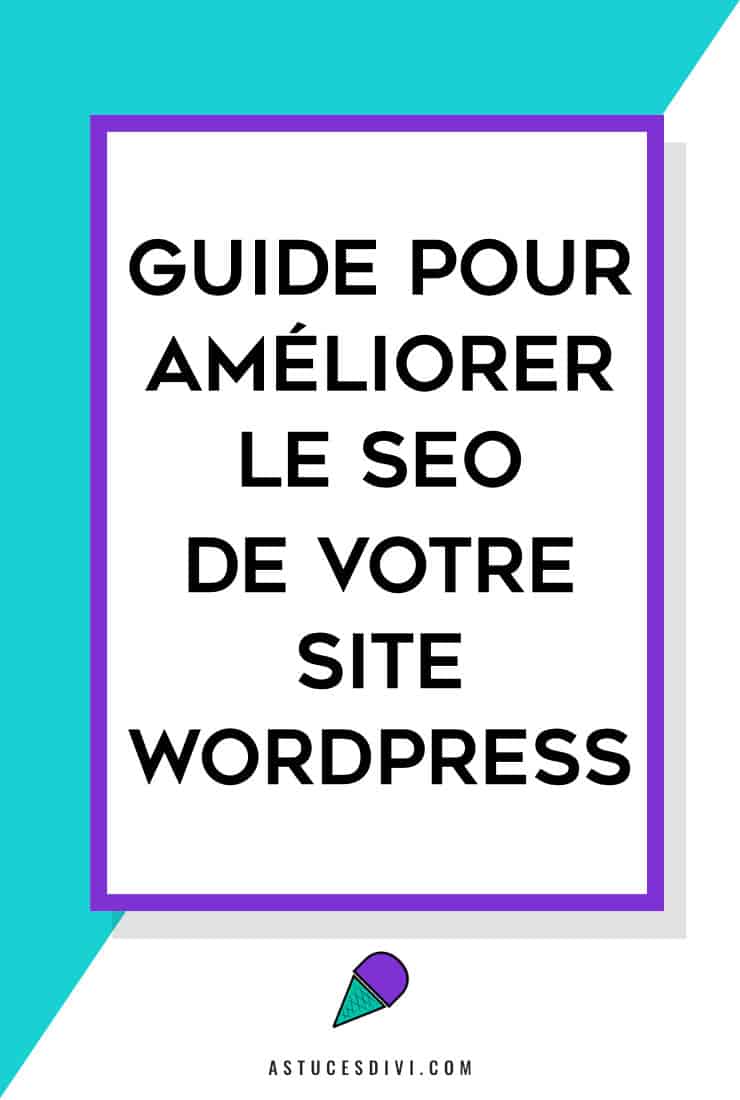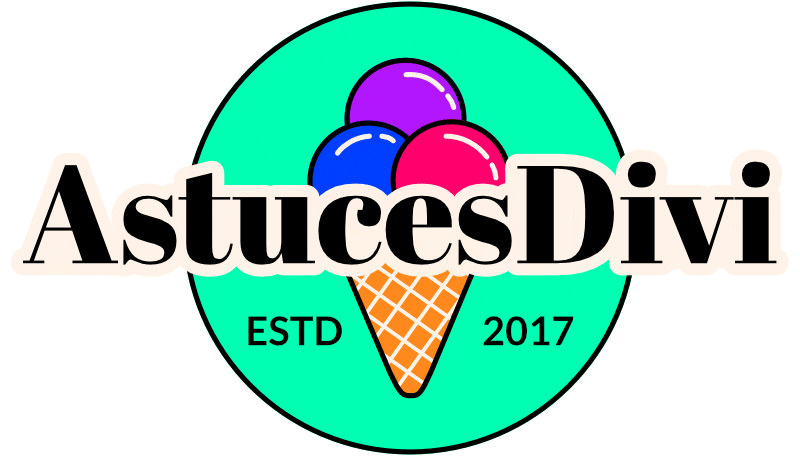Today we will not talk about Divi exclusively but rather about the SEO or natural SEO of your WordPress site in general.
On TipsDivi, you usually find tutorials to help you improve the design of your Divi site, but it would be a shame to put online a "cannon" site if nobody visits it, right?
So if you're starting to create websites, it's important to look at the issue of natural SEO.
I propose that you democratize the fundamentals of SEO so that a beginner can easily set up optimizations that will bear fruit.
Most experts agree that there are 3 pillars on which a good SEO strategy is based, i.e. an optimised site for natural SEO is based on:
- A good structure
- Good content
- A good netlinking strategy
Besides, we often talk about "SEO pyramid", which I have pictured here:

Let's take a closer look at this:
1 – Site structure
The structure of the site is the base of this pyramid. We could compare it to the foundations of a house.
If you build a very nice house but the foundations are not solid, early on you will have problems and this will lead to great work.
In the web, it's the same.
If the site is created from the wrong wayThis could be a brake on the proper referencing of the latter.
What is meant by "bad way"What should be done to ensure that the structure of your site is suitable and optimized?

Finally, the site structure is the most part technique of your SEO strategy.
The above image is not exhaustive but already lists several points you should focus on:
1.1 – WordPress settings
This is the base, this is what you are supposed to do right after installing WordPress on your remote server (hoster) or local server.
From the tab Settings from WordPress, you will discover several options, some of which are important. I am thinking in particular of the structure of your permalians.
By default, WordPress offers a structure "Date and Title" while a structure « Title of publication » is certainly more optimal.

However, if your site has been online for a while, it is not recommended to modify this structure because this could have a devastating effect on your natural SEO (many URL redirections should be put in place).
Therefore, it is recommended that these settings at the very beginning of creating your site.
Not to mention that your WordPress site should be installed on a secure URL (HTTPS).
1.2 – Use a SEO plug-in
In the image, you see « Yoast settings ». Indeed, this SEO plug-in is the most famous and most used. However, a French competitor is also very effective in optimizing your site's natural SEO: SEOPress.
These plug-ins allow you to correct certain behaviors of the WordPress CMS which are not optimal for natural SEO.
Thanks to the settings options of Yoast or SEOPress, you can remove some WordPress archive pages that have this unfortunate tendency to create from contents duplicated internally.
But that's not all! Thanks to these plug-ins, you can easily Optimize Meta Title tags (SEO title) and Meta tags Description (SEO description) that are decisive for the referencing of your pages and articles.
Finally, these extensions offer many other adjustment options which, depending on your choice, will still be possible. optimize your SEO site.
They also make it possible to exclude certain pages from indexing, which can be an asset depending on the nature of the index (pages of legal information, pages of privacy policy, page basket, page CGV etc.).
Therefore, it is strongly advised to use this kind of extension rather than the SEO options native to the theme Divi.
1.3 – Quality of the code
When using WordPress, we choose a theme that will define the overall design of the site. Unfortunately, not all themes are equal in the face of quality of code !
Some themes are coded to offer options and designs without taking into account the impact on SEO.
And we know: one developer is not a reference. Therefore, caution should be exercised when choose a WordPress theme even if the marketing department sells it as being SEO-Friendly.
Fortunately, the Theme Divi do not have any real code concerns that may impede the natural referencing of your site, however, I invite you to consult these 8 tips to help you optimize Divi even better for SEO.
1.4 - Optimization of robot.txt and .htaccess files
It is true that this part is rather technical. In files .htaccess and robot.txt lines of code can be drawn up to issue certain rules that would improve SEO.
However, this part is reserved for developers or people rather comfortable with the functioning of WordPress. I rarely venture on these grounds.
1.5 – The relevance of the internal structure
When you talk about site structure, we also talk about the internal structure :
- Pages-parent / page-child: This must be decided knowingly because the structure of the URL will be affected.
- Categories / Tags: Did you make the right choices? Is the classification of your blog articles relevant and ergonomic?
- The depth of pages: Are some pages too deep (do you need to click 3 or 4 times to reach them)?
- The main menu of your site (navigation): Is it relevant and ergonomic for your users?
- Use of silos: Have you optimized your internal structure to build silos? This ranking of your content by topic, more or less hermetic, can improve the SEO of a site in some cases.
- etc.
1.6 - Internal mesh
Even if this technique could have been classified in the "links" section of the SEO pyramid, internal meshing improves the structure of the site.
As a reminder, internal networking is the creation of links within your content that point to other pages or articles on your site.
This technique is easy to implement and allows for good results.
Moreover, silos structures are based on the internal mesh of the site. The main idea is optimize links between articles/pages the same theme (heading).
Don't hesitate to improve the links between your pages and articles. Don't forget either. edit your old articles to insert links that point to your new ones. You don't often take the time to do it and yet it's crucial!
2 - The content of the site
Beyond the technical part that makes it possible to set up a good site structure, another factor is just as important to position yourself in the search results: content of the site.
We will never repeat it enough: publish good content and your SEO strategy is half won!

You certainly know, Google focuses on quality content. When proposing a page or article on its results, it must be able to be "proud".
Would you recommend a bad plumber or a bad electrician to a friend? Certainly not! Well Google neither!
When Google indexes your content, it "reads" your texts (the robots scan the source code of your pages and articles) and determines whether they are of quality thanks to many criteria. Then it sets a position for your result.
These quality criteria include:
2.1 – Unique Content
Your texts must be original and unique in every sense of the word.
Of course, you won't do any copy and paste texts you found on another site. Even by changing a few words or phrases, it will be quickly spotted and you could be sanctioned.
Beyond plagiarism, attention must be paid to Duplicate Content within your site (content duplicated internally).
It's only by knowing the how WordPress works that the CMS duplicates our content natively. This can be largely avoided with extensions like Yoast or SEOPress but also by encoding some files within a theme child.
For example, if you are the sole author of your site, the author archive page will be a full copy of your blog page. Since these two pages offer the same content on 2 different URLs, we speak of Duplicate Content.
So make sure you correct this kind of mistake as quickly as possible.
2.2 – Key words and semantics
We can't. draft for the web Like we would do for the paper press. It is essential to optimize your texts and content for a targeted query.
This goes through the strategic choice of keywords and the use of extended semantics.
How could Google offer your page or article on a request entered by the user if its content is not optimized in this sense?
2.3 – Rich and quality content
Your content must meet a specific need and must do the question. If you only offer useless and interest-free information, the Internet user will leave immediately, which will increase your rebound rate and make decrease the average time spent on your site.
These indicators are very eloquent...
Beware, then, drafting useful and rich texts send good signals to Google. Of course, rich content is much longer (in number of words) than poor content, which is still a criterion of quality to care for.
2.4 - Structured content
It's not about saying "I will publish a 5000-word article and I will please Google"No!
In addition to everything you have just seen, your content must be structured, readable and digested for your readers:
- Screen your texts in paragraphs + subtitles (H2, H3, H4 etc.)
- Use chip lists or numbered lists
- Use it fat and italic to support certain ideas and keywords.
- Make short sentences and chapters.
- etc.
In short, this will help the reader not to "hatch" and allow Google robots to better understand your content.
2.5 - Frequency of publication
Here's a subject that hurts... The frequency of publication plays a role in Google's algorithm.
Even if nothing is proven, we notice that the more we publish, the more traffic increases. It's a kind of virtuous circle.
To put all the assets on your side, it is recommended to publish regularly: Every week ideally or every month if you cannot do otherwise.
This is why the question of keeping a blog in its showcase or e-commerce site is becoming evident to most commercial companies that have digitized themselves. I don't know any great brand that doesn't offer a blog or a very active news feed.
How can we win new keywords without regularly posting blog articles? WordPress is precisely the ideal solution to create a showcase or e-commerce site with a blog part.
However, keeping a blog takes a lot of time, personal investment and knowledge. It is also for this reason that the web writing market is expanding : web editor, SEO editor, storyteller etc.
2.6 - Many other criteria...
All the points listed so far are already a good starting point to optimize your content in order to improve your SEO.
Many other criteria can be taken into account, such as: images used, alternative text, external links, anchors, comments from your readers etc.
3 – Linking strategy
WordPress propels more than 34% of websites worldwide.
Imagine that a small percentage of these users perfectly optimize the structure AND content of their site. Imagine that, like you, they have a website with a healthy structure, they regularly publish quality content and all the lights are green. How will Google then be able to separate them? How can Google choose between two publications of equal quality?
Google's first page offers only a dozen results and places are "cheap". It is precisely thanks to the 3rd pillar of this SEO pyramid – links – that you will manage to win positions against your competitors!

When we talk about links, we talk more precisely about backlinks These are links from external sites that point to your site.
The big problem, with the backlinks, is that he is difficult to control, unlike all other types of optimizations we have just seen (structure, internal mesh, content quality etc.).
A good one SEO strategy goes hand in hand with a good netlinking strategy (= means used to obtain backlinks).
Unfortunately, this part of optimization is not simple and is often entrusted to SEO pros. However, here is what you need to know:
- The backlinks of a site allow Google to measure its popularity: the more links the site has, the more it is considered to be a "authority site".
- The provenance and anchors of your backlinks must be diversified: If all your links come from the same CMS, if all your links have the same anchor (= word under which is "hidden" your link), if all your links are "follow"... In short, if your backlinks are not diversified, Google might find this suspicious.
- The theme of your backlinks: If a make-up advice site links to a plumber site, this backlink will be considered null or even harmful. For a better SEO impact, links to your site must come from sites with the same theme as yours.
- Backlinks everywhere: Even if the home page of your site is the one that should get the majority of your backlinks, it may be an advantage to get links that point to other pages (or articles) of your site.
- Prefer quality to quantity: It is better to get some backlinks from "authority sites" rather than hundreds coming from "small sites" still not popular in Google's eyes. The quality of your backlinks has an important role in a netlinking strategy.
Although these last 5 points are very important to measure the popularity of your site and improve its natural SEO, the real question is: How can we get backlinks?
It's not easy, I agree with you, but nothing is impossible!
There are several known ways and I suggest you discover them in order of efficiency:
3.1 – The purchase of links
This is the easiest way to get backlinks without getting too tired: buy backlinks from publisher sites.
In the middle of the web, this Link purchase strategy is well known and widely used by SEO. But if you start, you may not be aware that there are platforms linking "advertising sites" to "publishing sites".
Of course, this strategy must be used intelligently to obtain natural netlinking in Google's eyes. There are many such platforms in France but the most qualitative is certainly CreaNico: SEMJUICE.
This platform allows you to register as a publisher (partner site that will host the backlink) or advertiser (the one that needs backlinks). Or both!
Thus, if your site has no backlink, you could start an effective link strategy by creating netlinking campaigns.
To better understand this particular operation, I invite you to read this detailed review.
3.2 – Publication of invited article
This is a fairly well-known and rather effective way of get a "follow" backlink. You can contact bloggers in your topic and offer them to write a quality article to post on their blog.
It is not a question of publishing a promotional article about the merits of your products or services, but rather a "advice" article that would give added value to the blog that will publish it.
Of course, you will not forget to introduce yourself and make a link to your site at that time.
This is a win-win solution because you get a free backlink and the blogger gets a quality article he didn't write.
3.3 – Active participation in an event
If you are participating in a regional or national event – for example, if you are a speaker, sponsor or even organiser – It is very likely that this event uses the web to promote it.
There is a great chance that the event site will link to your site. These baklinks are usually followed (links followed).
3.4 - Publication of the authority article
Here is another solution that could (nothing is safe) make you win some backlinks : draft a "mad article" on a topic of interest and hope that this article will be quoted by other bloggers or website publishers.
This will not cost you money but will take you a lot of time for writing and you are not sure of getting backlinks, unlike in purchase of links or publication of guest articles.
3.5 - Publication of article-review
An article-review is an article that gives an opinion on a product or service: it can be a tutorial, a test, etc.
If your article is of quality, there will be chances that it will be noticed by the brand or company in question that could make a link back to this publication.
This option will cost you nothing but doesn't work every time.
3.6 - Post comments on blogs in your topic
This is not the best of solutions to get backlinks because the links you post in the blog comment form are not of very good quality.
Let's say that in 99% of cases, backlinks are "nofollow". This means Google is not following them.
However, links nofollow are recorded within the Google Search Console and contribute to the creation of a "Healthy Links Profile".
3.7 - Other opportunities to get backlinks
We just saw the 6 best ways to get backlinks but they're not the only ones. There are other more or less valid ones:
- Sponsored articles: paid items promoting your company.
- PBN: on Private Blog Network or network of sites allow to create links but be careful, it is rather borderline.
- Social networks: articles shared on social networks are not taken into account by Google (links nofollow) but can improve your reputation and traffic of the site.
Don't delay! Discover the theme Divi here !
4 - All facets of natural SEO
I like to imagine that the famous SEO pyramid is not alone.
Google has gradually evolved its algorithm, it refines day by day and with each change, new quality criteria are incorporated.
It is certainly a titan job comparable to that of building the pyramids of Cairo...

I think then that beyond optimizing structure, content and links, other criteria are very important:
- The security of your WordPress site: Do not neglect this aspect because a hacked site will no longer be offered by Google and all the work done until then will be lost. That would be so bad!
- Performance: improving the performance of a site is certainly appreciative to the visitor. It's an essential comfort today. Google obviously prefers to offer high-performance websites in its search results.
- Accessibility: Is your site optimized for all visitors? Even for hearing impaired people, blind people etc.? The accessibility of a site is a quality criterion. This often goes through the coding of the theme but can be improved by other ways such as transcribing or subtitling your videos, font size, colors used, contrasts etc.
Finally, the third grey pyramid illustrated on my image may well be the future of what search engines expect from a quality site. I am thinking in particular of Artificial intelligence and other innovations that technology reserves to us...
Need more resources for Divi? Discover the other articles in this section!




4 Comments